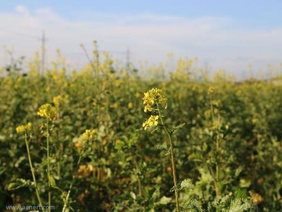Production of cellulosic ethanol is steadily increasing, but still can't compete with conventional bioethanol technologies. However, inventors' patenting activity in this sector remains high. The present review includes analysis of patent applications on cellulosic ethanol production that were published in 2015 in the major patent offices of the world. For the current year we have found 341 patent applications related to one or other phase of cellulosic ethanol production technology, including preliminary processing of raw material, primary processes and final processing of the product.
Among the patent applications published in 2015, the US patent and trademark office, where 32% of patent applications were filed, is leading by a significant margin. Prominent positions are also taken by World Intellectual Property Organization (16% of applications filed), National Institute of Industrial Property of Brazil (12%) and the European Patent Office (11%). Distribution of top ten patent offices, where the highest numbers of patent applications were published in 2015 is provided on the chart below.
Distribution of documents by patent offices
USPTO - United States Patent and Trademark Office; WIPO - World Intellectual Property Organization; INPI (BR) - National Institute of Industrial Property, Brazil; EPO - European Patent Office; SIPO (CN) - State Intellectual Property Office, China; JPO - Japan Patent Office; IP India - Intellectual Property India; CIPO - Canadian Intellectual Property Office; IP Australia - Intellectual Property Australia; IMPI - Instituto Mexicano de la Propiedad Industrial; Other - all other offices
In 2015 the USA and Brazil not only took the leading positions in terms of ethanol production capacities, but also became the two top national patent offices by the number of published patent applications related to cellulosic ethanol technologies, excluding regional and worldwide patent organization.
In approximately 59% of the cases the applicants filed their patent applications outside the countries of their registration. Among non-residents the most popular places to file an application were the patent offices in Brazil, the USA, China, Europe and Japan.
In 268 patent applications (79% of all the documents found) technical solutions are provided in the form of method, while compositions and materials are in the focus of 236 documents (69%). At the same time, new methods and compositions simultaneously are presented in 173 documents, which is a half of all the patent applications found in this group. The most popular IPC class among those assigned to the patent applications is C12P, which represents, in short, fermentation processes for synthesis or separation of chemical compounds.
The table below shows the distribution of the patent applications in accordance with the problems they are aimed to solve, according to the textual description of the documents.
Distribution of documents by problems and rating points
| Problem groups | Number of documents in a group | Share of total, % | Rating of group dcuments |
|---|---|---|---|
| Low efficiency of main processes | 228 | 41.2 | 6.9 |
| High costs in general | 104 | 18.8 | 7.4 |
| Environmental and social impact | 59 | 10.6 | 8 |
| High OPEX / Utilization | 52 | 9.4 | 8.1 |
| Low efficiency / Variety of feedstock | 38 | 6.9 | 8.5 |
| High OPEX / Poor performance | 29 | 5.2 | 6.8 |
| Unclear problem | 17 | 3.1 | 6.1 |
| High CAPEX / Equipment | 8 | 1.4 | 6.8 |
| High CAPEX / Development | 7 | 1.3 | 8.7 |
| Low efficiency of product treatment | 5 | 0.9 | 8.6 |
| Administrative and organisational problems | 4 | 0.7 | 7.8 |
| Low efficiency in general | 3 | 0.5 | 8.3 |
Approximately 2/3 of the revised patent applications to a greater or lesser degree concern the problem of low efficiency of primary processes in ethanol production, which is the most widespread problem in the current selection of patent documents. The authors of patent applications also pay particular attention to environmental aspects of ethanol production, the probabilities of cost reduction, namely, related to the necessity of mineral residue utilization, as well as to the problem of low efficiency caused by the specific nature of the feed material used.
The majority of patent applications concern the main processes of ethanol production – cellulosic biomass conversion into glucose and its subsequent fermentation. Thus, technologies and equipment intended for primary reactions are described in 202 documents, while compositions for primary reactions and methods for preparation thereof – in 199. Preliminary processing of raw material goes next by the number of patent applications that concern this topic (182 documents). Other phases of technology are described in the documents to a far lesser degree.
To find the methodology of this evaluation, as well as the analysis of the latest inventions in other important sectors of contemporary energy industry, please visit our web site www.aenert.com
